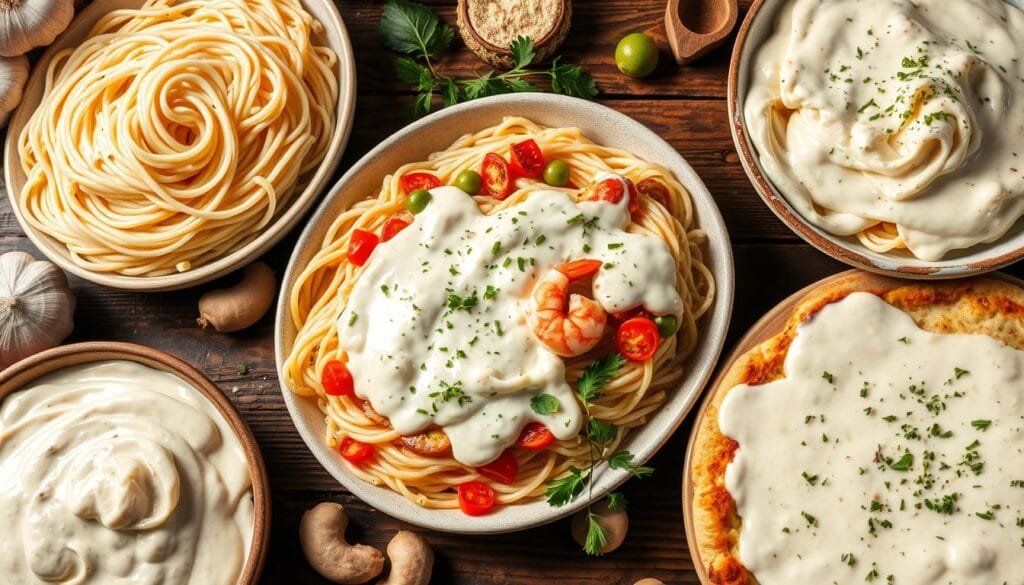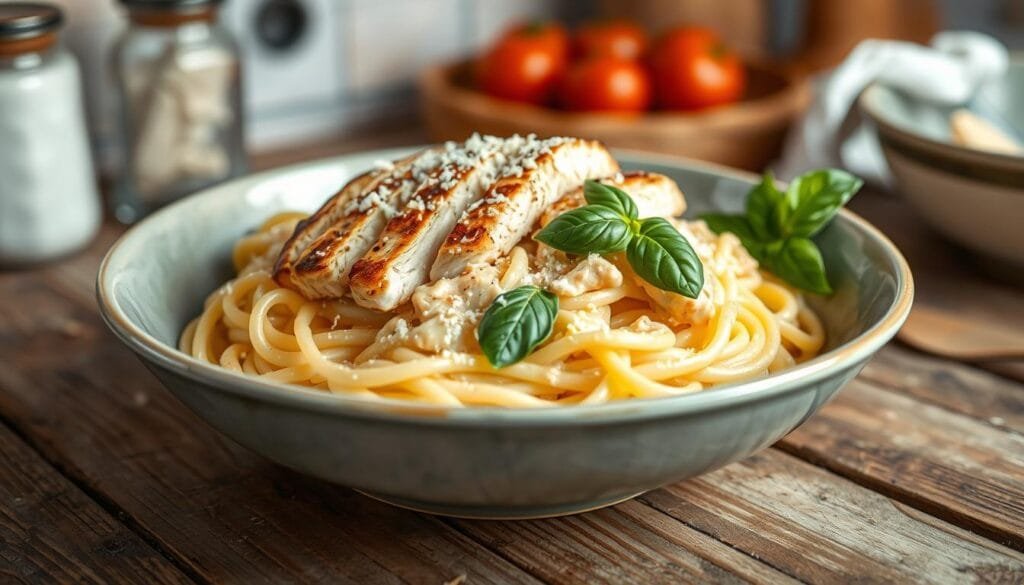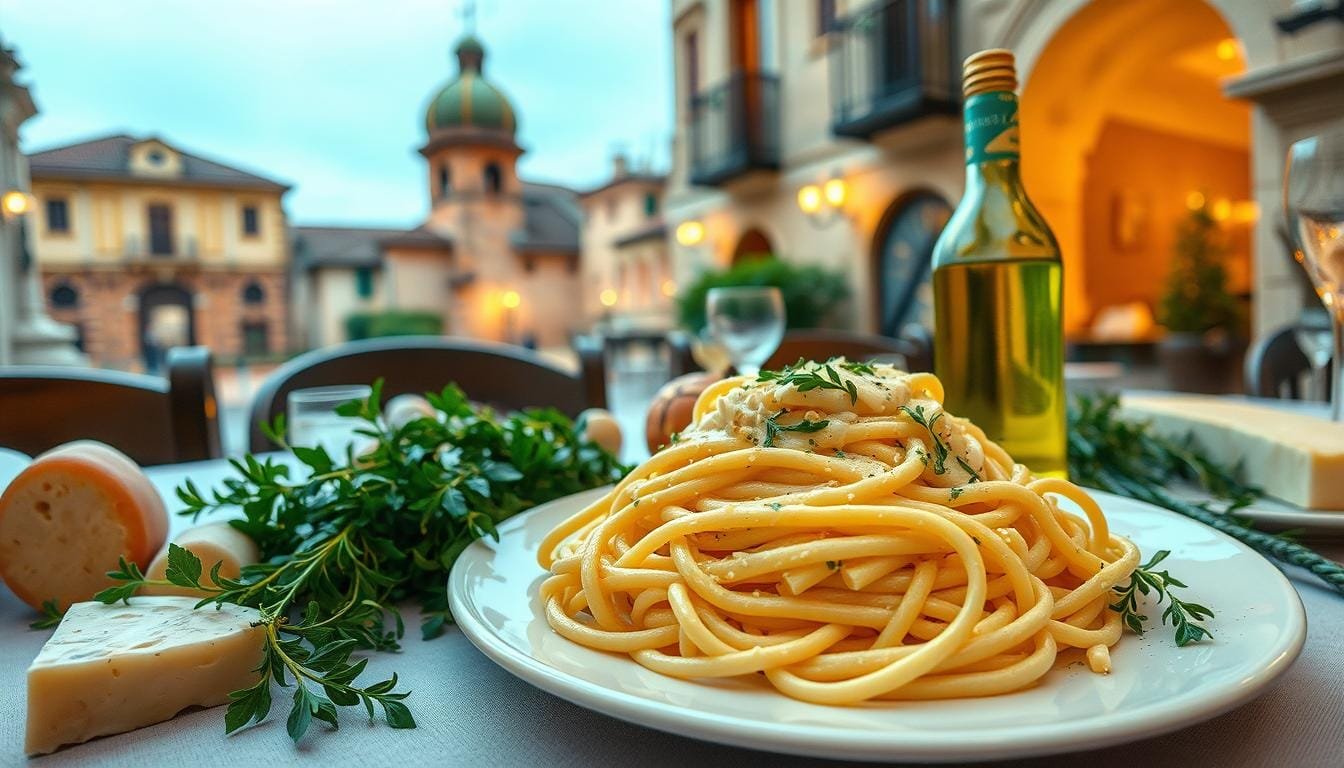Have you ever thought about how Fettuccine Alfredo became so popular? This creamy pasta is known for being indulgent and comforting. It has a rich history that shows how it grew from a Roman dish to a global favorite.
Fettuccine Alfredo started in Rome in the early 20th century. It was loved for its rich yet simple taste. This dish is a comfort food icon worldwide. It shows how food can cross cultural boundaries.
The story of Alfredo sauce is about more than just food. It’s about cultural exchange and adaptation. Alfredo sauce has won over people everywhere with its simple but delicious flavor. Let’s see how this simple Roman dish became known around the world.
Key Takeaways
- The first written record of pasta in Italy dates back to the 11th century, indicating its long-standing presence in Italian cuisine.
- Fettuccine Alfredo originated in early 20th century Rome, created by Alfredo di Lelio.
- Italian cuisine boasts hundreds of different pasta shapes, reflecting its diversity.
- 88% of Americans enjoy pasta regularly, highlighting its popularity in the U.S.
- Fettuccine Alfredo has evolved significantly, with numerous modern interpretations and variations.
The Origins of Fettuccine Alfredo in Rome
The story of Fettuccine Alfredo began in Rome. It quickly became a classic of Roman cooking. The dish is a perfect example of simplicity mixed with flavor. It captures the true culinary spirit of Italy’s capital.
Creation by Alfredo di Lelio
Alfredo di Lelio made Fettuccine Alfredo in 1914 for a special reason. He wanted to cook a wholesome meal for his wife, Ines, who was pregnant. This creation was a simple mix of fresh fettuccine, butter, and Parmigiano-Reggiano cheese.
Di Lelio’s method became famous for its creamy feel. And it did this without any heavy cream. This was a big moment in the history of cooking in Rome.
The Restaurant “Alfredo alla Scrofa”
The restaurant “Alfredo alla Scrofa” in Rome is where this dish was born. It opened its doors in 1914. The restaurant quickly got famous for making the best Fettuccine Alfredo. Both locals and tourists loved it.
Because of its fame, the restaurant caught the eye of famous people. These included George Bernard Shaw, Albert Einstein, and Amelia Earhart. Their visits helped the restaurant become even more popular.
Original Recipe and Ingredients
The original recipe for Fettuccine Alfredo is simple and elegant. It uses three main ingredients: fresh egg fettuccine, butter, and Parmigiano-Reggiano cheese. This approach focuses on fresh, quality ingredients. The true Roman version of the dish doesn’t use heavy cream. This keeps it authentic.
Even though the dish has changed in many places, its heart stays the same. The history of Fettuccine Alfredo in Roman cuisine still excites and pleases food lovers everywhere.
The Introduction of Fettuccine Alfredo to America
The journey of Fettuccine Alfredo from Rome to America is a captivating tale. It’s all about cultural exchange and adaptation.
Hollywood Endorsement by Mary Pickford and Douglas Fairbanks
Mary Pickford and Douglas Fairbanks brought Alfredo to Hollywood’s attention. They visited Alfredo di Lelio’s restaurant in Rome during their 1920s honeymoon. They praised the dish and gave Alfredo a golden fork and spoon. This act made Fettuccine Alfredo famous worldwide, with lots of coverage in American media.

Adapting to American Tastes
Once in America, Fettuccine Alfredo changed to match local tastes. The original had just fettuccine, butter, and Parmigiano-Reggiano. But American chefs added heavy cream. This made the sauce richer. It also helped Fettuccine Alfredo become a key part of Italian-American cuisine.
Role in Italian-American Cuisine
The dish quickly became popular in the US. It became a key part of Italian-American dining. This was thanks to its Hollywood fame and mentions in media.
Restaurants and Alfredo sauces in stores made it a common choice. Now it’s a staple in American kitchens and eateries.
Here is a snapshot of Fettuccine Alfredo’s journey and its significant points of transformation:
| Event | Details |
|---|---|
| Original Creation | 1914 by Alfredo di Lelio in Rome; fettuccine, butter, and Parmigiano-Reggiano |
| Hollywood Endorsement | 1920 by Mary Pickford and Douglas Fairbanks during their honeymoon |
| American Adaptation | Inclusion of heavy cream to cater to American tastes |
Through these key events, Fettuccine Alfredo has become a beloved dish. It has a strong place in both Italian and American food culture. It’s celebrated for its delicious, comforting taste.
Transformations of Alfredo Sauce in the United States
The journey of Fettuccine Alfredo in the U.S. is amazing. After arriving in America, it changed in many ways. These changes made Alfredo sauce match American tastes and cooking styles.
Addition of Heavy Cream
A big change in the U.S. was adding heavy cream to Alfredo sauce. Originally, in Italy, it was just butter, Parmesan cheese, and pasta water. Yet, American chefs added heavy cream. This made the sauce thicker and tastier.

Commercialization and Prepared Sauces
Pre-packaged Alfredo sauce has become popular in the U.S. Now, supermarkets sell many kinds of Alfredo sauces. They add things like flour or cornstarch to make them last longer. This has made Alfredo sauce a common choice in American homes.
Modern Interpretations and Variations
Now, Alfredo sauce comes in many new forms. We add chicken, seafood, and vegetables. Chicken Alfredo is especially loved in homes and restaurants. This shows how much Alfredo sauce has changed over time.
These changes in Alfredo sauce in the U.S. show how new ideas and traditions blend together. This keeps Alfredo sauce popular in homes and restaurants all over the country.
Modern Variations of Alfredo Dishes
Today’s Alfredo dishes have evolved, incorporating diverse ingredients and flavors. They range from protein-rich versions to ones loaded with vegetables. This ensures there’s an Alfredo dish for every taste.
Chicken Alfredo
Chicken Alfredo adds hearty protein to classic Alfredo sauce. It features tender chicken, offering a balanced meal for any occasion. It’s a favorite because you can make it in under 30 minutes.
It’s perfect for busy weeknights. The creamy sauce and savory chicken combine to create a comforting, satisfying dish.

Seafood Alfredo
Seafood Alfredo is for those seeking luxury. It may include shrimp, scallops, or crab meat. This upgrade takes the dish to gourmet levels.
The mix of seafood and creamy sauce is balanced perfectly. It impresses guests by showing Alfredo sauce’s adaptability with different seafood.
Vegetable Alfredo
Vegetable Alfredo adds a healthy twist. It includes broccoli, spinach, and bell peppers. Not only does it boost nutrition, but it also brings color and texture.
This version is great for vegetarians or those wanting more vegetables. It proves Alfredo can be both indulgent and healthy.
| Variation | Key Ingredients | Cooking Time | Servings per Batch |
|---|---|---|---|
| Chicken Alfredo | Chicken breast, Alfredo sauce, fettuccine | Under 30 minutes | 3 to 4 |
| Seafood Alfredo | Shrimp, scallops, Alfredo sauce, fettuccine | Approximately 30 minutes | 3 to 4 |
| Vegetable Alfredo | Broccoli, spinach, Alfredo sauce, fettuccine | Under 30 minutes | 3 to 4 |
These updates to Alfredo dishes show the recipe’s flexibility, appealing to various tastes and needs. Choose from Chicken, Seafood, or Vegetable Alfredo for a unique, tasty meal. Their quick preparation time makes them perfect for any occasion.
Is Alfredo a Cultural Food?
To find out if Alfredo sauce is a cultural food, we’ll look at where it comes from. It started in Italy and became popular in the U.S. It’s known worldwide now.
Alfredo di Lelio made it first in Rome in the 1920s. It was just pasta with butter and Parmesan for his wife. It has changed a lot since then, especially in America.
In America, famous stars like Mary Pickford and Douglas Fairbanks loved Fettuccine Alfredo. Their approval brought the dish fame. It’s changed over time here, becoming richer and creamier.
In Italy, it’s not often called “Fettuccine Alfredo.” It may be known as pasta in bianco. But Americans have changed it, adding things like chicken and shrimp.
| Criteria | Italy | United States |
|---|---|---|
| Name Recognition | Rarely known as Fettuccine Alfredo | Commonly known and served |
| Ingredients | Butter, Parmesan only | Heavy cream, chicken, shrimp, etc. |
| Restaurant Presence | Few | Widespread, especially in Italian-American chains |
| Target Audience | Tourists | Mainstream |
This table shows how Alfredo sauce is seen differently in Italy and the U.S. Alfredo sauce has become a big part of world cuisine. It clearly shows Alfredo sauce is a cultural food worldwide.
The Role of Fettuccine Alfredo in Popular Culture
Fettuccine Alfredo is a true culinary icon. Its journey from a simple dish to a cultural staple is fascinating. You can find it in cookbooks and on cooking shows. It’s known as a comfort food, making it popular in American homes.
Stars like Mary Pickford and Douglas Fairbanks helped make Alfredo famous. They ate it in Rome during their honeymoon in 1920. Their love for the dish spread it to the United States. The gold spoon and fork they gave Alfredo are now legendary.
Alfredo’s fame in media grew from there. A recipe appeared in the U.S. shortly after its Rome debut. It’s been in books and on screens, celebrated for gatherings and special meals.
Fettuccine Alfredo symbolizes both indulgence and simplicity. Its basic ingredients allow for creativity. In the U.S., it’s often made with cream, showing its adaptability. This dish continues to win over hearts worldwide.
Seeing Alfredo as comfort food in pop culture highlights its appeal. It connects us through a love of food, family, and hospitality. Alfredo isn’t just food; it’s a cultural sensation. It’s cherished both in high-end spots and at our dinner tables.
The Cultural Impact of Alfredo Sauce Worldwide
Alfredo sauce, with its creamy texture and deep flavor, started in Italy. Now, it’s loved worldwide. The Alfredo global influence shows as the sauce changes and fits into many international cuisines.
Regional Adaptations
In the United States, Alfredo sauce often has heavy cream and different cheeses. But in Italy, chefs stick to the original with butter and Parmesan. This shows how Alfredo sauce changes based on the place.
Integration into Global Cuisines
Alfredo sauce has also become popular far from Italy and the US. In Mediterranean countries, it’s paired with seafood. In Northern Europe, it’s stirred into casseroles. Its ability to blend with local flavors makes it a global favorite.
Influence Beyond Italian Restaurants
Fettuccine Alfredo has moved well beyond Italian dining. It’s now found worldwide in different types of restaurants. This shows the Alfredo global influence. Its rich taste and creamy texture win hearts everywhere.
| Aspect | Original Italian Alfredo | American Adaptation |
|---|---|---|
| Ingredients | Butter, Parmesan cheese | Heavy cream, various cheeses, garnishes |
| Restaurant Presence | Alfredo alla Scrofa, Il Vero Alfredo | Widespread across the U.S. |
| Popularity | Home-cooked, specialty dish | Mainstream, varied interpretations |
| Customer Base | Tourists | Tourists and locals |
Conclusion
Our journey through the history of Alfredo sauce has shown its amazing transformation. From its beginnings in Rome, it has become loved worldwide. Alfredo di Lelio created this dish in the early 1900s, introducing the world to Italian flavors. After World War II, Italian-American restaurants made it famous.
In the 1940s and 1950s, it became a favourite in these places. It wowed people with its creamy taste and richness. The simple mix of fettuccine, butter, Parmesan, and pasta water is a masterpiece of Italian cooking.
The 1970s and 1980s saw Alfredo sauce winning hearts in American and Black Southern kitchens. It started to use different pastas, like penne and linguine. By the late 1990s and into the 2000s, even hip-hop music mentioned it. This showed its deep cultural impact.
Alfredo sauce continues to inspire us today. Social media in the 2010s made it even more popular. Now, we enjoy new twists like Alfredo stuffed bell peppers and Alfredo pizza. These dishes showcase the sauce’s wide appeal in today’s cuisine.
Alfredo sauce is celebrated for its creamy, comforting taste. It’s a testament to the ever-changing world of food. For a detailed look at its history, click here.
FAQ
Is Alfredo a Cultural Food? Exploring Origins
Alfredo sauce started in early 20th century Rome. It went from a local favorite to a worldwide comfort food. This shows its cultural importance and deep roots in cooking history.
How did Fettuccine Alfredo originate in Rome?
In 1914, Alfredo di Lelio made Fettuccine Alfredo in Rome for his pregnant wife. He used fresh fettuccine, butter, and Parmigiano-Reggiano cheese. Alfredo alla Scrofa was the first place to serve it. They focused on high-quality ingredients to highlight the dish’s natural tastes.
What role did Hollywood stars play in introducing Fettuccine Alfredo to America?
Mary Pickford and Douglas Fairbanks brought Fettuccine Alfredo to the U.S. They visited Alfredo’s restaurant on their honeymoon in the 1920s. Their support helped make this dish loved by Americans.
How did Alfredo sauce evolve in the United States?
In the U.S., people started adding heavy cream to Alfredo sauce. This changed Alfredo di Lelio’s original recipe. It made the sauce richer and creamier.
What are some modern variations of Alfredo dishes?
Today’s Alfredo dishes have new versions. Chicken Alfredo adds protein. Seafood Alfredo includes shrimp or scallops. And Vegetable Alfredo brings in greens like broccoli or spinach. These add nutrition and variety.
Does Fettuccine Alfredo have significance in popular culture?
Fettuccine Alfredo is big in popular culture. It’s in cookbooks, TV shows, and movies as a classic comfort food. It’s linked to luxury and celebration.
How has Alfredo sauce impacted global cuisines?
Alfredo sauce has changed food around the world. It’s in many restaurants and blends into different food traditions. This shows its wide cultural influence.
